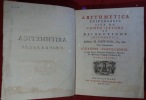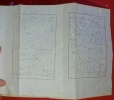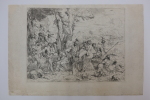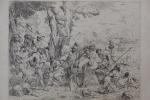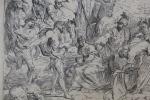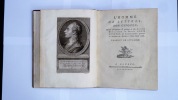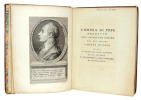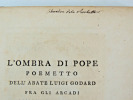46 books for « castiglione »Edit
-
Type
Autograph (1)
Book (46)
-
Century
16th (2)
17th (1)
18th (5)
19th (2)
20th (9)
21st (8)
-
Countries
Belgium (3)
Canada (1)
China (3)
Denmark (1)
France (31)
Germany (1)
Italy (5)
Switzerland (2)
-
Syndicate
ALAC (1)
ILAB (27)
NVVA (2)
SLACES (2)
SLAM (18)
Topics
- Algeria (1)
- Army (1)
- Autographs (1)
- Books from the xviiith (3)
- Castiglione (38)
- China (2)
- China (2)
- Drawings (1)
- Early printed books (1)
- Engraving (books about) (1)
- First edition (1)
- Fishes (1)
- Fishing (1)
- French directory (1)
- Gallantry (1)
- Games toys (1)
- Gastronomy food (1)
- History (5)
- Horse (1)
- Humanism (1)
- Isaac (1)
- Italian (1)
- Italian literature (1)
- Jacob (1)
- Literature (1)
- Maps (1)
- Michon pierre (1)
- Newton (1)
- Paintings (1)
- Philosophy (1)
- Policy (2)
- Portugal (1)
- Posters (1)
- Religions (1)
- School (1)
- Vito (6)
Cloulas Ivan Castiglione-Minischetti Vito
Reference : 100124849
(2001)
ISBN : 2235023088
Mémoires d'un pape de la Renaissance : Les Commentarii de Pie II
Tallandier 2001 collection "relire l'histoire". Paris. in8. 2001. Broché. 532 pages. Etat Correct couverture usagée interieur propre
Palais, Pavillons et Jardins construits par Giuseppe Castiglione dans le domaine impérial de Yuan Ming Yuan au Palais d'été de Pékin 1783-1786.
Paris, Jardin de Flore, 1977. 4 prints, each ornately depicting Western-style palaces from within the Yuanmingyuan, inscribed with the name of the palace and location and the numerical sequence, 87.8cm x 50cm (34,5 inc. x 19 inc.).87.8cm x 50cm (34œin x 19Ÿin) (20). Price is for one print only. 4 prints will cost 1440 euros. Each print is sold separately. Please inquire before ordering.
Nouvelle édition de 4 planches gravées en taille douce, de 1783 à 1786, par des artistes chinois et représentant les palais, pavillons, jardins et pièces d'eau édifiés pour l'empereur K'ien-Long, par les jésuites de la Cour de Chine, sous la direction de Giuseppe Castiglione, de 1737 à 1766. La composition du titre et du texte a été exécutée entièrement à la main par le maître imprimeur Dominique Viglino, à Bourg-la-Reine. Le papier utilisé est un vélin à la forme, en pur chiffon, spécialement fabriqué par le Moulin du Gué.Tirage : 250 exemplaires numérotés.The present set of prints was reproduced in 1977 as a limited edition of 250 copies from the original 1786 edition of copper-plate engravings, commissioned by the Qianlong Emperor.The Qianlong Emperor realised his vision of a new European-style palace with the construction of the Yuanmingyuan (Garden of Perfect Brightness), designed by the Jesuits Giuseppe Castiglione and Michel Benoist. During the height of the Emperor's reign (1736-1795), the Yuanmingyuan was part of an architectural complex which boasted a sheer grandeur of over 320 hectares of land, more than ten times larger than the entire precinct of the Forbidden City. These grounds were known as the 'three hills and five gardens' because they comprised the Yuanmingyuan, Changchunyuan and Qingyiyuan on Longevity Hill; the Jingmingyuan on Jade Fountain Hill; and the Jiyuyuan on the Fragrant Hills.The Qianlong Emperor so adored the Yuanmingyuan that from his reign onwards, the Imperial Court moved to the Yuanmingyuan every year after the Spring Festival (Lunar New Year) and resided there until the sixth month when the heat set in.These key locations and architectural marvels are depicted in the present 20 engravings.
Palais, Pavillons et Jardins construits par Giuseppe Castiglione dans le domaine impérial de Yuan Ming Yuan au Palais d'été de Pékin 1783-1786.
Paris, Jardin de Flore, 1977. 4 prints, each ornately depicting Western-style palaces from within the Yuanmingyuan, inscribed with the name of the palace and location and the numerical sequence, 87.8cm x 50cm (34,5 inc. x 19 inc.).87.8cm x 50cm (34œin x 19Ÿin) (20).
Nouvelle édition de 4 planches gravées en taille douce, de 1783 à 1786, par des artistes chinois et représentant les palais, pavillons, jardins et pièces d'eau édifiés pour l'empereur K'ien-Long, par les jésuites de la Cour de Chine, sous la direction de Giuseppe Castiglione, de 1737 à 1766. La composition du titre et du texte a été exécutée entièrement à la main par le maître imprimeur Dominique Viglino, à Bourg-la-Reine. Le papier utilisé est un vélin à la forme, en pur chiffon, spécialement fabriqué par le Moulin du Gué.Tirage : 250 exemplaires numérotés.The present set of prints was reproduced in 1977 as a limited edition of 250 copies from the original 1786 edition of copper-plate engravings, commissioned by the Qianlong Emperor.The Qianlong Emperor realised his vision of a new European-style palace with the construction of the Yuanmingyuan (Garden of Perfect Brightness), designed by the Jesuits Giuseppe Castiglione and Michel Benoist. During the height of the Emperor's reign (1736-1795), the Yuanmingyuan was part of an architectural complex which boasted a sheer grandeur of over 320 hectares of land, more than ten times larger than the entire precinct of the Forbidden City. These grounds were known as the 'three hills and five gardens' because they comprised the Yuanmingyuan, Changchunyuan and Qingyiyuan on Longevity Hill; the Jingmingyuan on Jade Fountain Hill; and the Jiyuyuan on the Fragrant Hills.The Qianlong Emperor so adored the Yuanmingyuan that from his reign onwards, the Imperial Court moved to the Yuanmingyuan every year after the Spring Festival (Lunar New Year) and resided there until the sixth month when the heat set in.These key locations and architectural marvels are depicted in the present 20 engravings.
Madame la Comtesse de Castiglione et Napoléon III ou Le bal aux Tuileries le mardi 29 janvier 1856
Paris 1856 | 30 x 24 cm | une feuille sous marie-louise
Encre originale signée et datée de Charles Robert, intitulée "Madame la Comtesse de Castiglione et Napoléon III ou Le bal aux Tuileries le mardi 29 janvier 1856". Cette encre immortalise la rencontre historique de la Comtesse de Castiglione, alors âgée de 19 ans, et l'empereur Napoléon III au cours d'un bal donné par la princesse Mathilde. Investie par Cavour d'une mission diplomatique délicate, la jeune comtesse était arrivée à Paris dans le but deséduire l'Empereur des Français afin de le rendre sympathique à la cause piémontaise, et ainsi le convertir à l'idée d'une Italie unifiée. Elle entretiendra une célèbre liaison avec l'Empereur qui aura pour conséquence le raffermissement des liens entre la France l'Italie qui prendra fin après l'attentat contre Napoléon III perpétré par des carbonari italiens dans la nuit du 5 au 6 avril 1857. Esthétique représentation des débuts de cette Mata Hari italienne, ambassadrice et espionne au sein de la cour impériale. - Photographies et détails sur www.Edition-Originale.com -


Phone number : 01 56 08 08 85
Everlasting Verdure of The Immortal Calix - An Album of Flower Studies
Taibei Shi: Guo li gu gong bo wu yuan, Minguo 60 [1971]. 1 large in-plano (50*36 cm) portfolio, silk-covered hard boards, [2] folded leaves, [16] folded leaves of mounted plates, illustrated by sixteen large size flower paitings by Castiglione, a very good copy. Very heavy, extra-postage required.
Lang Shih-ning (Giuseppe Castiglione 1688-1766) was a native of Milan, Iyaly. At the age of 19, he entered the Society of Jesus as a novitiate. Trained as a painter and architect, he was sent to China at the age of 27 to serve as a missionary. He arrived in Peking during the 54th year of the K'ang Hsi reign in 17125, and made the Church of St. Joseph his living quarters. He was summoned to the Palace to serve as a Court painter in the Imperial Academy. As Lang Shih-ning's works were collected by the Imperial Palace, the number of paintings attibuted to him now extant outside the Palace collection are very few.
CASTIGLIONE.- SHOU-CHIEN, S. / GOURAUD, J.-L. / CHENG-SHENG, T. / CARTIER, M.
Reference : 129310aaf
Giuseppe Castiglione dit Lang Shining 1688-1766.
Favre, 2004, in-4to, 147 p., + 1 planches dépliantes en couleurs, richement ill. couleurs par des peintures de Giuseppe Castiglione, reliure en toile originale avec jaquette.
Giuseppe Castiglione, né le 19 juillet 1688 à Milan et décédé le 16 juillet 1766 à Pékin, est un frère jésuite italien, missionnaire en Chine et peintre à la cour impériale. Il fut l'un des artistes préférés des empereurs de la dynastie Qing. En 1716 il prend le nom chinois de Lang Shining.

(SLACES, NVVA)
Phone number : 41 (0)26 3223808
L' HOMME DE LETTRES , BON CITOYENDiscours philosophique et politique (...) prononcé à l' Académie des Arcades, a Rome l' année 1776 Traduit de l' italiensuivi de : REFLEXIONS SUR LA POESIE ECRITES EN FRANCOIS PAR L' ILLUSTRE AUTEUR et de :ESSAY ANALYTIQUE SUR LES DECOUVERTES CAPITALES DE L' ESPRIT HUMAIN( traduit de l' italien par l' auteur et par Gueneau de Montbeillard )
Genève s. n. 1777 1è éd. française . 1 vol. in-4 ( 24,5 x 20 cm)CXXIV ppEn frontisp. remarquable portrait du prince de Castiglione d'après Domenico Corvi gravé par Giovanni Volpatto.En fin de la première partie, figure un Sonnet de Corilla au prince philosophe (en italien).Pleine basane mouchetée. Dos lisse orné de fleurons dorés; p. de titre maroquin havane. Roulettes dorées encadrant les plats. Toutes tranches dorées. Gardes marbrées.Qqs épidermures er rayures sur les plats. Mors inférieur fendu sur 1 cm en tête. Petite tâche marginale p. CV.
La lignée de Castiglione et Solferino est une branche cadette de la famille Gonzaga (ou Gonzague ). Louis (1745-1819) est un arrière petit-fils de Ferdinand III de Castiglione , dernier souverain régnant , qui avait dû fuir en 1691. Alors que l'autorité impériale avait séquestré leurs fiefs, les Gonzague vécurent en exil à Venise et en Espagne. En échange d'une rente, Louis renonça à ses droits en faveur de l'Autriche.L'Académie d' Arcadie ou Académie des Arcades fut fondée à Rome par des poètes en 1690 : usages inspirés de la mythologie et de la culture grecques. Le nom fait référence à " L' Arcadie", poème pastoral écrit par Jacopo Sannazaro de 1483 à 1501, et à la région du Péloponnèse. Vers 1700, l' Arcadie comptait 600 membres : écrivains, poètes, compositeurs, musiciens.Philippe ou Philibert Gueneau de Montbeillard (Semur-en Auxois1720- Paris1785) continua la Collection académique de Dijon, recueil qui contient un choix de mémoires des diverses académies européennes. Ami de Buffon , il participa à l' Histoire des oiseaux ; il donna un article à l' Encyclopédie.Corilla était le nom donné à une célèbre improvisatrice qui se faisait admirer par ses connaissances et ses talents poétiques.A Rome, elle improvisa devant le cardinal de Bernis, ambassadeur de France. L'Arcadie de Rome l'admit en son sein ; elle fut couronnée au Capitole. (d'après Supplément au dictionnaire historique de l'abbé de Feller, 1819, vol.2 , p148-149). (Quérard , La France littéraire...1829, p.408 )
Phone number : 05 53 48 62 96
L'Homme de Lettres, Bon Citoyen, Discours philosophique & politique de son altesse Monseigneur le Prince Louis Gonzaga de Castiglione : prononcé à l'Académie des Arcades, à Rome l'année 1776. Traduit de l'Italien.
A Genève, , 1777. In-4 de CXXIV pp., veau havane marbré, dos lisse orné, pièce de titre en maroquin rouge, filet et frise dorés d'encadrement sur les plats, tranches dorées (reliure de l'éditeur).
Première édition française tirée à cent exemplaires selon Quérard, traduit de l'italien par l'auteur et Guénaud de Montbéliard. Suivi de :Réflexions sur la Poésie, écrites en François par l'Illustre Auteur ; Essai analytique sur les Découvertes capitales de l'Esprit humain, Prononcé à la Société Royale de Londres, l'année 1777. Par son altesse Monseigneur le Prince Louis Gonzaga de Castiglione. Une deuxième édition fut publiée en 1785. Portrait de l'auteur en frontispice, gravé par Volpatto d'après Corvi.
Le Livre du Courtisan
Editions Gérard Lebovici, Paris, 1987. In-8, broché sous couverture rempliée et illustrée en couleurs, xlvi-405 pp. Présentation de Baldassar Castiglione, par Alain Pons - Note sur la présente traduction - Bibliographie - Petit dictionnaire biographique - Dédicace - Livre Premier - Livre Deuxième - Livre Troisième - Livre Quatrième - Table.
--- Plus d'informations sur le site archivesdunord.com
Phone number : 01 42 73 13 41
La Divine Comtesse. Etude d’après Madame de Castiglione. Préface par Gabriele D’Annunzio.
Paris, Goupil, 1913. in 8°, plein maroquin aubergine, dos à nerfs orné de caissons dorés, décor doré sur les plats, tête dorée, roulette intérieure dorée et gardes de soie verte, couverture conservée, menus défauts à la reliure restaurée (Reliure de Durvand). (3)ff.-VII-247 pp.-(1)f.,
planches gravées hors texte en noir et en couleurs. EDITION ORIGINALE. Tirage limité à 200 exemplaires numérotés sur Hollande Van Gelder. Robert de Montesquiou, qui ne la connut pas, fut fasciné par cette personnalité hors du commun sur laquelle, le premier, il rassembla tous les documents qu’il put trouver notamment une impressionnante collection de plus de 400 photographies. Relié en tête : gravure de Jeanniot représentant le pavillon de Montesquiou — un article tiré de la revue Beaux-Arts du 1er mars 1934 — retirage d'une photo de la comtesse de Castiglione.Joint : Bulletin de souscription.
IL CORTEGIANO.
appresso Domenico Farri, Venetia, 1568. In-16 p. (mm. 151x103), p. pergamena coeva (restaurata per piccole manc.), 20 cc.nn. (di cui 1 bianca tra le cc. 14 e 15), 220 cc.num.; al frontespizio grande marca tipografica in silografia (donna alata di profilo, la Speranza, poggiata sul mondo, anch'esso alato, con le mani giunte e la testa rivolta al sole i cui raggi piovono dal cielo); testo in corsivo ornato da bei capilettera figurati. Opera di Baldassarre Castiglione (1478-1529), scritta tra il 1508 e il 1516, ma poi attentamente riveduta sino al 1528, anno della sua pubblicazione. Il "Cortegiano" uno dei libri più noti e più rappresentativi del Rinascimento italiano, svolge in quattro libri le conversazioni tenutesi per quattro sere di seguito alla corte di Urbino: ne sono interlocutori alcuni tra gli illustri personaggi dell'epoca. Il "Cortegiano" è insieme un galateo e un codice; il codice della finezza del pensiero e del gusto fatta eleganza e raffinatezza del costume". Cosi' Dizionario delle Opere Bompiani,II, p. 464.Manca all'Adams. Corto del marg. super.; risg. sciupati; con traccce d'uso e lievi arross. per lo più margin. interc. nel t., ma complessivam. un buon esemplare.
THE BOOK OF THE COURTIER.
Done into English by Sir Thomas Hoby, Anno 1561. J.M. Dent & Sons / E.P. Dutton & Co., London & Toronto / New York, s.d. (1928). In-16 (mm. 172x107), lussuosa legatura in p. pelle stile 500 chiusa da legacci, pp. XVIII,(2),324,8 (di cat. edit.), con bel frontespizio decorato. Ristampa del Libro del Cortegiano di Baldassarre Castiglione, pubblicata a Venezia nel 1528. Volume della Collana Everyman's Library.Ben conservato.
Copie de la lettre écrite par le Commissaire du Directoire exécutif près l'Armée d'Italie. au commandant de la neuvième Division militaire
Nîmes, J.B. Guibert, s.d. (1796) placard in-folio, En feuille (47 x 37 cm).
Reproduit la lettre, datée de Milan du 19 thermidor an IV [6 août 1796] et annonçant, sans le citer un seul instant, la victoire de Bonaparte à Castiglione (18 thermidor - 5 août) sur les troupes du général Wurmser, qui fut contraint de s'enfuir précipitamment et de rejoindre le Tyrol, ce qui permit aux Français de reprendre le siège de Mantoue, un moment levé. - - VENTE PAR CORRESPONDANCE UNIQUEMENT
NEWTON (Isaac), CASTIGLIONE (Giovanni Salvemini da, ou Jean de Castillion)
Reference : 16870
(1761)
Arithmetica Universalis ; sive compositione et resolutione arithmetica (...) Cum commentario Johannis Castillionei (...)
1761 Amsterdam, Marc Michel Rey, 1761, 3 parties en 2 tomes rel. en 1 vol. in 4 de (6)-XVIII-310-(2) pp. ; (4)-288 pp. ; (2)-134-(2) pp., pages de titres imprimées en rouge et noir, 37 planches dépliantes gravées, rel. début XIXe de plein veau brun raciné, dos richement orné de fers dorés, pièce de titre de maroquin rouges, tranches jaspées de couleurs, bel ex.
Cette édition comporte d'importants commentaires du mathématicien Giovanni Francesco Mauro Melchior Salvemini da Castiglione (1708-1791). Elle contient dans la dernière partie, des traités additionnels par Halley, Colson, Maclaurin, Campbell, Baermann, Kästner et Boscowitch (le dernier paraissant ici pour la 1re fois). Ex libris armorié gravé de Georges BONTEMPS (1799-1883).
Laban à la recherche d'idoles parmi les possessions de la famille de Joseph
Dimension extérieur 30,4 x 45,2 et cuvette 25,4 x 33,4 cm. Eau-forte réalisée par Giovanni Benedetto Castiglione, célèbre peintre, graveur et imprimeur italien de l'école génoise Baroque, sa ville de naissance. Gravure sur papier vergé datant environ de 1630, travail considéré comme l'un des premiers de l'artiste. En très bon état pour une œuvre de cette époque, on peut simplement noter une déchirure restaurée en bas au milieu.
Ici, il est dépeint une scène issu de l'histoire de Jacob de la Genèse.
L'isole piu famose del Mondo. Arettino e intagliate da Girolamo Porro Padovano. Con l'aggiunta di molte isole all' ill.re s. conte Georgio Trivltio. - [THE CULMINATION OF THE ""BOOK OF ISLANDS""]
Venetia [Venice], apresso gli heredi di S. Gagliani, 1590. [Colophon: In Vintia, appresso Giorgio Angelieri, a instantia de gli heredi di Simon Gagliani de Karera, 1590]. Small folio. 18th century (ab. 1780-90) half vellum with gilt leather title label to spine. Corners a bit bumped and title label a bit worn, otherwise nice and tight. A very nice copy, on thick, crisp paper. A few quires browned and brownspotted, and some occasional lighter browning. Four leaves with a marginal worm-tract, far from affecting text. Beautiful engraved title-page, consisting of a wide architectural border illustrated with large figures, putti, globes, and various symbols. Beautiful large woodcut initials and head- and tail-pieces. 47 half-page engraved maps in the text (by Porro, of islands and continents), excellent, crisp impressions. Large woodcut device to colophon. (12) ff., 201, (1) pp.
Third, much enlarged edition (with 47 maps as opposed to the mere 30 of the first edition) of Porcacchi's great book of islands, arguably the most famous of all ""isolario""s, with the 47 finely engraved maps by the famous map-maker Girolamo Porro, which also include maps of non-insular places, e.g North America and Mexico City, the famous city plan of Venice and that of Constantinople. Porcachhi's great ""isolario"" represents the culmination of the ""book of islands""-genre, both in regards to artistic quality and the information provided. It furthermore constitutes a main work in the history of the published knowledge of farther parts of the world and an important link in the development from what we call the ""book of islands"" to the modern atlas. As such it is of great value in several respects, both historically, culturally, and cartographically. ""The ""book of islands,"" or isolario, a novel form of cartographic book combining maps and narrative-historical chorography, was invented and initially developed in Italy during the fifteenth and sixteenth centuries. According to R.A. Skelton, ""like the portolano, or pilot-book, to which it was related, it had its origins in the Mediterranean, as an illustrated guide for travelers in the Aegean Archipelago and the Levant."". The first ""book of islands"" was authored by a Florentine ecclesiastic [around 1420] named Cristoforo Buondelmonti [...].The ""book of islands"" was eventually superseded as a cartographic genre, as was the ""Geographia"" of Ptolemy, by the modern atlas"" it persists even after Abraham Ortelius's 1570 ""Theatrum orbis terrarium"", but at the margins rather than at the center of the history of cartography. While the ""isolario"", Ptolemy's ""Geographia"", and the ""modern"" atlas coexist for some time, the gradual eclipse of the ""book of islands"" at one level reflected a progressive decentering of the Mediterranean that occurred within the broader context of early modern history, following the Atlantic discoveries. But well before that happened, in conjunction with the culminating moment of the discoveries and exploration period and at the height of the high Renaissance, the second printed ""book of islands"" appeared in 1528 in Venice published by Zoppino: the ""Libro di Benedetto Bordone nel qual si ragiona de tutte l'isole del mondo"" [Book of Benedetto Bordone in which are discussed all the islands of the world]. As the title suggests, this ""isolario"" provided even broader coverage than the Martellus recensions of Buondelmonti and gave special prominence to the islands of the New World [...].Da li Sonetti's translation of Buondelmonti's ""book of islands"" into a cycle of sonnets in Venice represented in its way an expression of the same desire to reconcile contemporary geographical knowledge to Italian vernacular traditions of geographical poetry that Berlinghieri's poetic Ptolemy expressed. But while the tradition of Tuscan geographical poetry would not survive the Quattrocento, the prose book of islands did, thanks especially to the Venetian print culture that was responsible for da li Sonetti and that produced Bordone's High Renaissance print ""isolario"". As mentioned, the print genre ""book of islands"" would endure in fact, albeit at the margins of modern cartography and literature, in multiple editions of Bordone, which were followed by the no less successful Tommaso Porcacchi's ""L'isole più famose del mondo"" (1572"" with copper-plate engravings), a line that continued through the seventeenth century [...] But just as with other major literary fields of endeavor including the political (Machiavelli), the pastoral (Sannazzaro), the courtly-bureaucratic (Castiglione), and the epic-novellistic (Ariosto), the ""isolario"" produced its masterpieces in the discoveries and travel writing field(alongside Columbus, Vespucci, and Verrazzano) during the High Renaissance."" (Cachey, ""From the Mediterranean to the World: A Note on the Italian ""Book of Islands"" (""isolario"")"", pp. 1-10). Shirley T.POR-1d" Phillips: 50.
THE BOOK OF THE COURTIER BY COUNT BALDESAR CASTIGLIONE (1528)
Charles Scribner's Sons. 1903. In-4. Relié. Etat d'usage, Couv. défraîchie, Dos fané, Intérieur acceptable. 439 pages. Reproductions en noir et blanc en frontispice et en page de titre. Illustré de nombreuses reproductions en noir et blanc sur planches hors texte. Couverture fortement défraîchie et se détachant. Dos des plats défraîchis. Frontispice détaché. Pages globalement fraîches.. . . . Classification Dewey : 420-Langue anglaise. Anglo-saxon
Trans. from the Italian by Leonard Eckstein Opdyke. With 12 portraits and 15 autographs. Classification Dewey : 420-Langue anglaise. Anglo-saxon
L’homme de lettres bon citoyen, discours philosophique et politique…
1777 Genève. 1777. 2 parties en 1 volume petit in-4, plein veau porphyre, dos lisse orné, pièce de titre en maroquin havane, guirlande de fleurs en encadrement sur les plats, tranches dorées.XXIV pp., III pp., (1) p., XXVI-CXXIV pp.
Edition originale française, traduite par Guéneau de Montbelliard, de ce discours philosophique prononcé à l’Académie des Arcades à Rome en 1776. Il est suivi d’un autre discours sur les Réflexions sur la poésie et d’un Essai analytique sur les découvertes capitales de l’esprit humain. Portrait-frontispice de l’auteur par Domenico Corvi, gravé par Volpatto. Grand voyageur, ami des Encyclopédiques, il était apprécié pour son esprit et sa foi dans le progrès humain par l’exercice de la raison.Tirage de luxe sur papier vergé fort tiré seulement à 100 exemplaires selon Barbier.Barbier, II, 855. Quérard III, 408. Bel exemplaire.
Station d'aquiculture et de pêche de Castiglione.-
Nouvelle Série. N°3. 1951. Alger. Heintz. 1951. In-8 (158 x 239mm) broché, couverture verte imprimée et ornée d'une gravure de poisson, 228 pages, tableaux dépliants, illustrations en noir dans le texte et 4 planches couleurs hors texte dont 3 représentent le Tripterygion tripteronotus Risso. Impression sur papier glacé. Exemplaire réinserré dans sa couverture sinon bon état.
L'ombra di Pope. Poemetto dell' abate Luigi Godard fra gli arcadi Cimante micenio in cui si lodano gli studi filosofici di sua altezza il sig. principe D. Luigi Gonzaga di Castiglione.
Signature autographe " Chardon de la Rochette " Portrait de l'auteur en frontsipice volume relié in 4, 230x180, relié plein veau raciné, tranches dorées, accrocs & manque, très belle condition intérieur, CXXI pages, sans page de titre, 1777 ref/24
Simon Chardon de La Rochette, né à Saint-Sauveur-de-Ginestoux en 1753, mort le 18 septembre 1814 à Paris, est un philologue et bibliographe français.
L'ombra di Pope. Poemetto dell' abate Luigi Godard fra gli arcadi Cimante micenio in cui si lodano gli studi filosofici di sua altezza il sig. principe D. Luigi Gonzaga di Castiglione.
Signature autographe " Chardon de la Rochette " Portrait de l'auteur en frontsipice volume relié in 4, 230x180, relié plein veau raciné, tranches dorées, accrocs & manque, très belle condition intérieur, CXXI pages, sans page de titre, 1777 ref/24
Simon Chardon de La Rochette, né à Saint-Sauveur-de-Ginestoux en 1753, mort le 18 septembre 1814 à Paris, est un philologue et bibliographe français.
IL LIBRO DEL CORTEGIANO.
Colla vita di lui scritta dal Sig. Abate Pierantonio Serassi. appresso Giuseppe Comino, Padova, 1766. In-8 gr. (mm. 252x189), cartoncino rustico coevo, tit. ms. al dorso, pp. XXIV,352; marca tipografica al frontespizio, con il bellissimo ritratto dell'A. inc. in rame da M. Francia; ornato da pregevoli grandi capilettera figur. a vignetta, testate e finali. Dedica al conte Antonmaria Borromeo, con il suo stemma, il tutto inc. in rame. Seconda edizione cominiana (la prima, illustrata, è del 1733). Cfr. Gamba,296: Angelo Comino fece una ristampa in Padova, 1766, del solo libro del Cortegiano. E' molto pregevole sì per la Vita premessavi (dell'Abate Serassi), sì per l'assistenza prestatavi dall'abate Giuseppe Gennari - Brunet,I,1628.Esemplare con barbe, ben conservato.
IL LIBRO DEL CORTEGIANO.
Società Tipografica Classici Italiani, Milano, 1803. In-8 p. (mm. 220x141), 2 volumi, brossura editoriale (lievi segni duso, etichette ai dorsi), pp. XL, 263; 226; con ritratto dell'Autore inciso in rame. Cfr. Fusi, p. 65: "Ediz. fatta sulla Cominiana del 1755, e colla restituzione dei passi mutilati" - Brunet,I,1630. Testo ben conservato, con barbe.
SENTIMENTI DI S. CARLO BORROMEO INTORNO AGLI SPETTACOLI.
appresso Pietro Lancellotti, Bergamo, 1759. In-8 (mm. 235x180), cartoncino rustico mod., tit. ms. al dorso, pp. (4),XII,220,(2), con ritratto di S. Carto disegnato ed inc. in rame da Mercorus; ornato da grandi capilettera e con una testata alle armi di Monsignor Cristoforo De' Migazzi, Arcivescovo di Vienna, cui è dedicata l'opera, in xilografia. Interessante raccolta di disposizioni prese dall'Arcivescovo di Milano fra il 1565 e il 1584, per impedire spettacoli religiosi e profani, persino in collegi. "Edizione originale", rara.Frontesp. con angolo infer. mancante (non di testo), picc. fori di tarlo nelle ultime carte, altrimenti fresco esemplare con barbe, ben conservato.
Michon Pierre, Castiglione Agnès,Biasi Pierre-Marc
Reference : R200119101
(2007)
ISBN : 2226179682
Le roi vient quand il veut - Propos sur la littérature
Albin Michel. 2007. In-8. Broché. Bon état, Couv. convenable, Dos satisfaisant, Intérieur frais. 393 pages. Jaquette en bon état.. Avec Jaquette. . . Classification Dewey : 840.092-XXI ème siècle
Classification Dewey : 840.092-XXI ème siècle
 Write to the booksellers
Write to the booksellers
![Everlasting Verdure of The Immortal Calix - An Album of Flower Studies. [CHINESE PAINTINGS] [CASTIGLIONE] [LANG SHIH-NING]](https://static.livre-rare-book.com/pictures/AHK/6390_1_thumb.jpg)
![Everlasting Verdure of The Immortal Calix - An Album of Flower Studies. [CHINESE PAINTINGS] [CASTIGLIONE] [LANG SHIH-NING]](https://static.livre-rare-book.com/pictures/AHK/6390_2_thumb.jpg)
![Everlasting Verdure of The Immortal Calix - An Album of Flower Studies. [CHINESE PAINTINGS] [CASTIGLIONE] [LANG SHIH-NING]](https://static.livre-rare-book.com/pictures/AHK/6390_3_thumb.jpg)





